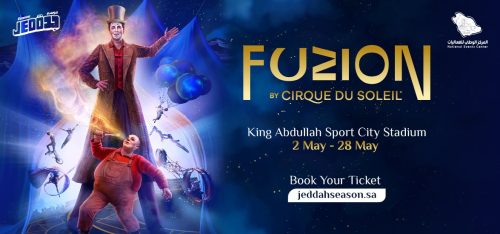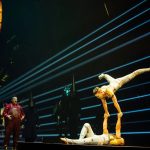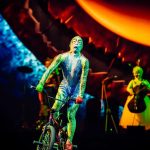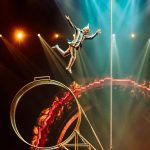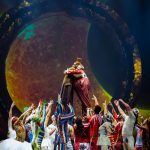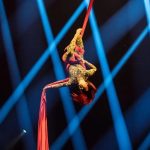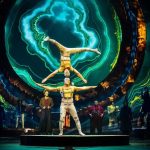FUZION by Cirque du Soleil is, as the name suggests, a fusion of some of the Canadian troupe’s best moments. These highlights from previous shows are woven together around three characters following their destinies through this strange world. Mikki Kunttu, international lighting, video, and set designer and frequent Cirque du Soleil collaborator, has re-imagined the new world for these well-known highlights.
Q. This production is based in Saudi Arabia, where is it staged?
The venue is called King Abdullah Sports City, also known as The Shining Jewel, and it is located 30 km north of Jeddah. FUZION is staged at the basketball arena that is located just next door to the main football stadium.
Q. What was your main source of inspiration on this project?
The theme of the show was “The Best of Cirque,” so the inspiration was really in the visual language of Cirque and especially in the classic big-top setting. The design wanted to bow to the tradition of Cirque, but at the same time I wanted to take advantage of the technical possibilities within such an arena. So kind of big-top inspired, but without the technical restrictions of a big top.
Q. Circles feature heavily in the lighting and stage design.
Yes, indeed, circular form is very central to the design. The circular shape for the stage comes from the idea of creating a similar intimacy and spirit that you’d have in a big top. Though the performance space is large, no seat is too far and we do not have “bad” seats in the audience. The VIP seats embracing the stage are very close to the main performance area and that’s really optimal for clown acts for example. As far as perspective is concerned, it’s not only upstage/downstage depth I’m considering with this stage. The depth in height becomes a very important factor with all the aerial acts and also the wheel of death. This, again, relates directly to lighting and how the rig is layered and organized in space. I don’t really see any difference with sets, lighting or video. They all create the same thing, the three-dimensional space in relation to time. Yes, one is constructed of plywood or whatnot and the other is pixels, but what counts is the end experience and I’m not really interested in what the technique is.
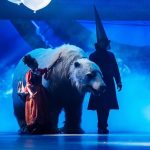
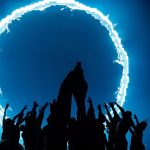
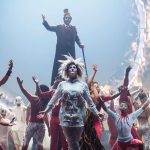
But back to the design… After the main stage was conceived, which was decided to be a 14m-diameter circle with a 10m-diameter turntable and some circular stairs around it, the background and the band riser formed themselves naturally around this theme of circularity. In the middle of the circular RP screen hangs the main set piece, “The Donut” (as I call it), that is a mix between a gold, bronze, and metallic structure that both splits the RP in two areas (one inside and one outside The Donut) and also has 60 pcs of JDC-1 strobes inside it. The idea was to make The Donut work as a lit set piece as well as a massive source of light, sort of the sun of the stage if you like. And I wanted to both start the show and end the show with this Pink Floyd-style, larger-than-life brightness. So the light in The Donut is really my Marc Brickman tribute!
Q. Can you walk through your fixture choices for the two trusses and also the sidelights?
For lighting positions I have two straight standard backlight trusses, two circular trusses above the stage, a circular horseshoe truss above the VIP bleachers and a FOH truss that also horsehoes around the hall. The sidelights are on their own ladders, two sets SL and two SR. Two clusters of nine PRG Icon Edge fixtures hang just onstage of the main PA. I do not have a lot of floor units on the show, I generally do not like seeing lighting fixtures on stage when I look at the performers, and especially for this show I wanted to have a very clean stage. I tend to say, “If I want to see fixtures, I go visit a rental shop.”
Q. What are your workhorse fixtures that you like to use?
MK: I’m really quite flexible when it comes to choice of fixtures. I look at the quality of the gear, but also often we need to balance it with budget, availability, and really the stock of the rental company who got the show. So a lot of times you’ll end up with the best possible compromise. That’s just the way it works and I’m fine with it as long as the gear is in good clean shape and it has been properly prepped and maintained. This show was a big BMFL show with mainly Robe BMFL Blades and BMFL WashBeam fixtures in the rig. The BMFL range has become the workhorse of our industry and the quality of the light is really really good. I’m a big fan of the washbeam fixture.
Q. You are an old hand at designing for the circus now. Can you share your guidelines, designing for aerials for example?
Designing for circus acrobats is different to anything else within the performing arts. The difference is that real factor of danger that is present every time certain acts are on stage. So my aim is to work together with the artists and the trainers in order to establish a happy marriage of working conditions for the acrobats and the visual narrative of the show. I tend to believe if you started your design process taking the right perspective, these are one and the same thing and the safety factor is often delivered naturally. In technical terms, what the special character of aerial circus means, I try to shy away from LED-faced washlights such as B-Eye, Quantum Wash and so on, as they have multiple lenses each and their blinding is therefore very difficult or impossible to control. For this type of circus act I like to keep to flat front lens old-school fixtures whenever possible.
Q. There is a beautiful green malachite effect on the backstage wall, I can’t tell if this was a projection or a lighting effect.
One of the most successful parts of the design is exactly this. The Donut sinks in with the lighting and projection on the back wall so nicely that at times it is really impossible to say what is a concrete set piece and what is content. In most of the scenes the background is a mix of video content, The Donut, and the lighting on The Donut and around it.
Q. At the top of the show there is a Bedouin tent onstage lit from within, and then the tent disappears. How did you illuminate it?
The disappearing tent is one of my favorite effects. The tent for me is like a “dream of a big top” that our main characters are searching for and trying to grasp. The tent is a very thin fabric that only hangs by thin ropes in the air and it covers all of our turntable, so the diameter is around 10m. At the top of the show, our whole cast is inside the tent, but you do not see them as the tent is only lit from outside. As we kick into the opening of the show, the tent is removed by a super fast sniffer and at the same time we drop our big kabuki right behind it revealing the whole stage and the cast and getting into the introduction of characters with the first number. I just love the poetry and magic of how the big tent disappears from stage in a blink of an eye. The lighting for the tent is fully from outside and it is really really simple, just a little blue from here and there and a nice dimmer effect to build up the suspense getting into the moment of the big reveal.
Q. What was the biggest challenge on this show?
This show was conceived under lucky stars as we did not really have any major show stopping problems. With circus you don’t have any full programming days, it is all done on overnights through the production. That takes a lot of concentration from all the crew and days tend to be super long and you really need to keep yourself focused and try to rest what you can. I think my biggest challenge in Jeddah was the fact that I lost my sleep for some reason and slept like three to four hours a night for five weeks.
Q. What is your favorite part of the design on this show?
I think what is there really serves the show and no element is there just for it’s own sake. Every element builds the big picture of the performance and I believe both the sets and the lighting succeed in supporting every act we put on stage. I loved working with Mukhtar. [Mukhtar Omar Sharif Mukhtar]. He is such a respectful, considering, talented director and a beautiful soul. I cannot stress enough how much I appreciate this way of working where everyone is respected as a person and as a human being and as a professional. I would say Mukhtar’s way of working, this type of teamwork, that just radiates the love everyone from the cast to the creatives to the crew has for their own craft, is really my favorite part of this particular creation. It’s all about the people and what we do and how we are together.
Q. What are you working on next?
I just finished preprogramming MUV, a show that Cirque is opening in Andorra this summer. I’m doing sets and lighting design for this one as well, and it is exciting to get back to Andorra, which is such a beautiful destination.
Gear List
GLP Impression X4 @ 350w 82
PRG Icon Edge @ 470w 72
Robe BMFL Washbeam @ 2kw 59
Robe Robin BMFL Blade @ 2kw 127
Chauvet COLORado Batten Q15 @ 197 36w
ETC Source4 LED 36deg @ 140w+cyc adapter 15
PRG GC Bad Boy Spot @ 1.4k 4
JDC-1 Strobes 60
Creative Team
Marie-Josée Adam – Executive Producer/Head of Creation
Stefan Miljevic – Creative Director
Mukhtar Omar Sharif Mukhtar – Show Director
Mikki Kunttu – Lighting and Set Designer
Madeleine Bernatchez – Props Designer
Hugo Montecristo – Music Director, Composer and Arranger
Germain Guillemot – Acrobatic Performance Designer
Audrey Toulouse – Make-up Designer
Nicolas Vaudelet – Costume Designer
Mark Vreeken – Sound Designer
John Cartin – Acrobatic Choreographer
Geneviève Dorion-Coupal – Acrobatic Choreographer
Olivier Goulet – Video Content Designer
{ SOURCE: Live Design Online }
